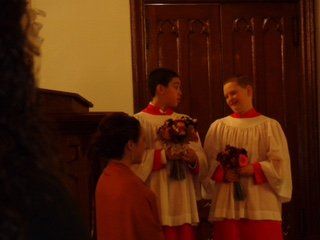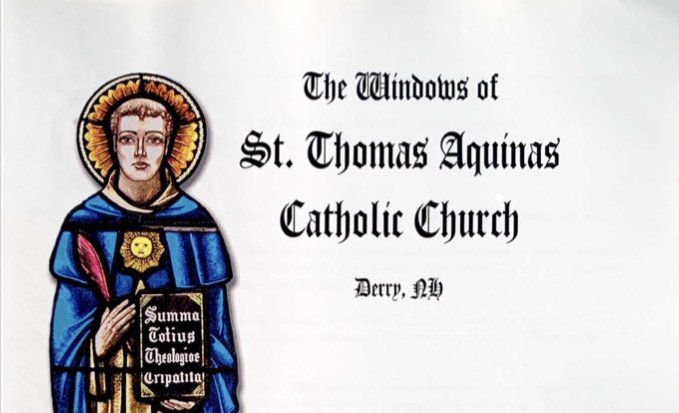In June of 1868, a group of 5 or 6 families comprised the Catholic population of the town. Reverend John O’Brien, first pastor of St. Joseph’s church in Manchester, officiated Mass in the home of John Duffy. At irregular intervals, Mass was said in the homes of Daniel Owens, James Madden and others during the following years by Reverend William J. McDonald or one of his assistants. When the number of Catholic settlers outgrew the capacity of the homes, Mass was said in Smith’s Hall, Bell’s Opera House and other public halls in town. There were several priests including Reverend Maurice Galvin, Reverend Andrew Timon, Reverend John J. Lyons and Reverend E.D. Mackey officiating at different times throughout the years. This was how the Catholic community functioned for the next 17 years.
In 1885 St. Thomas Aquinas became a mission parish of St. Anne (est. 1848, the only Catholic Church in Manchester) and was visited once a month. The Church community was under the pastoral care of the pioneer priest from St. Anne in Manchester, Reverend William J. McDonald (1813-1885). Upon Father McDonald’s death the pastoral care for St. Thomas Aquinas was under the direction of Bishop Denis Mary Bradley at St. Joseph Cathedral in Manchester.
On August 15, 1888 brought the formal formation of the parish by the appointment of its first resident pastor. Father William J. O’Connor was so designated by the Most Reverend Denis M. Bradley and shortly after took up his duties here. The parish included Derry proper, Epping, Goffs Falls and as well as Salem, Windham, Chester and Sandown.
Naturally, the Catholic families in Derry were delighted to have a resident pastor and gave whole-hearted cooperation in building up the infant parish. It is noted, the non-Catholic people of the town were not laggard in giving a helping hand.
Upon arrival in Derry, Father O’Connor at once organized for work and held regular weekly Mass in Smith Hall and later at the Opera House. By commendable efforts, he then began the erection of the large church which stands on Crystal Avenue.
The first Baptisms, officiated by Father O’Connor, were on August 26, 1888. The children were: Miriam Teresa Lynch, daughter of Thomas and Maria Lynch, and Miriam Idam Provencher, daughter of Major and Sara Provencher. (Miriam I. Provencher died on September 7, 1910.)
In April of 1889, the present property of the Church was purchased from George S. Rollins (1803-1888) with house, barn, shed and about ¾ of an acre of land at a cost of $3,000. Rollins had proposed to construct an avenue through the remainder of the lot, which was to be laid out in building lots.
Architect Elsworth Martin was awarded the contract to build the church. In May of 1889 the parish congregation commenced breaking ground preparing to build their church edifice. On Friday, September 20, the cross for the church was placed in position on the steeple. The construction of the church cost about $10,000. Total debt incurred was $13,000.
Twelve of the early pioneer parishioners banded together and donated 12 stained glass windows for the new church. The windows were gifts of: Bishop Bradley, Reverend Andrew Timon, John Duffy, Daniel Owens, James Madden, Joseph Jordan, Martin Eagan, Richard J. McHugh, Urbane Lamy, Catherine O’Connor and two were “In Memory Of” Michael Lane and William Lane.
On November 29, 1888, Father O’Connor officiated at the first marriage between John Henry Starr of Manchester and Anna Webster of Londonderry.
On November 28, 1889 St. Thomas Aquinas Church was dedicated with Bishop Bradley presiding and preaching. At a Solemn High Mass of dedication the Very Reverend John Barry, then Vicar General of the Diocese was celebrant with 15 priests con-celebrating. After Mass, a turkey dinner, catered by F.B. Butler, was provided for about 100 people. The parish community had grown to 60 families.
On August 2, 1914, headlines in The Derry News: Catholic Church Burned and Beautiful Building on Crystal Avenue Destroyed. At 3:00 p.m. on Sunday afternoon the alarm was sounded. The horse drawn fire department made a rapid response and soon had three hydrants pouring water upon the building. The low pressure of the water was apparent as was the fact that the church was nearly as high as the standpipe. The fire spread rapidly. It was remarkable that no lives were lost and no other buildings were affected. The origin of the fire was a mystery and it is assumed it must have started near the altar then spread rapidly under the entire roof. Father Dunn said the building and its furnishings were well insured. He was of the opinion the church would be rebuilt as soon as possible. Meanwhile, Father Dunn busied himself with the building of the new church and used the Scenic Theater on Railroad Avenue for Sunday Mass. Many difficulties had to be met and overcome.
The proposed plan of the rebuilt church was that it be set back from the street, would be of brick and the seating capacity would be for about 1,000 persons. This would require a church building twice as large as the former one.
The old church structure had been in use for a quarter century. The new church will be much larger and more commodious than the former one. The new building is of gothic architecture and of the most modern design and arrangement throughout. It has an electric lighting system that is perfection itself and, in all ways, is constructed to meet the demands of a rapidly growing parish, for which Father Dunn has labored to have completed and which now stands as a monument of pride to himself, the parishioners and his many friends. The cost of construction reached up to the $100,000 mark with the main church having a seating capacity of 860 and about the same number of seats in the basement. (Dunn, c. 1917)
Sunday, November 11, 1917, will long be remembered by the members of St. Thomas Aquinas Catholic Parish for on that day their fine new large church edifice was formally dedicated to the worship of God. The weather was all that could have been desired and the large congregations were present at all the services of the day.
At the early morning Mass held in the basement of the church, there was a large attendance including the children who were to receive Confirmation in the afternoon. At 10:15 Solemn High Mass was said before a congregation that completely filled the main church upstairs. The celebrant was the pastor, Reverend Daniel J. Dunn and was assisted by Reverend Father Frank Lyons as deacon, and the Reverend Elzéar N. Durette, the pastor’s assistant curate as sub-deacon, with Reverend Father Leddy of Manchester as Master of Ceremonies. The Solemn High Mass was celebrated before the Right Reverend A. George Albert Guertin, D.D., Bishop of the diocese and a score of priests from Manchester and other cities and towns.
Every seat in the large church was filled by 10:00 a.m. and all waited patiently for the services of the dedication to begin. At the close of Mass and benediction the solemn and very impressive service of saying the prayers for the dead was performed with the Bishop as leader. This was certainly an engaging service to all present. The large congregation was in perfect stillness as the Bishop recited the well known prayers of the church.
At the noon hour Bishop Guertin and the 21 priests in attendance were the special guests of Father Dunn at a grand dinner at Hotel Bradford. Landlord Thyng made an exception to his rule; whereby, he does not serve any meals to the public nowadays, but opened his dining rooms giving Father Dunn and his friends’ one of the very best dinners it was possible for him to prepare. The dinner was especially nice in every detail and was highly complimented by the Bishop, Father Dunn and all his guests.
At 3:00 p.m. in the afternoon the church was again opened and the Sacrament of Confirmation was conferred upon 120 children who were seated in the front pews. The rest of the pews were filled with interested persons; even extra chairs were brought in to accommodate the eager listeners. No doubt more than 1,000 persons were in attendance at this service. (Dunn, c. 1917)


